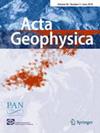卫星重力梯度恢复误差模型的精确建立及未来GOCE后续任务需求分析
IF 2.1
4区 地球科学
Q2 GEOCHEMISTRY & GEOPHYSICS
引用次数: 4
摘要
首先,利用功率谱原理,以星载梯度计重力梯度和星载GPS/GLONASS接收机轨道位置为主要误差源,有效地建立了用于累积大地水准面高度误差估计的单一和组合误差模型;在250度处,基于新组合误差模型的累积大地水准面高度误差为1.769 ×10−1 m,较好地符合德国发布的GOCE-only地球重力场模型go_con_gcf_2_tim_r2的恢复精度为1.760 ×10−1 m。因此,本文建立的累积大地水准面高程组合误差模型是正确可靠的。其次,从重力梯度与轨道位置等关键载荷匹配测量精度的优选设计和卫星轨道高度的优化选择等方面对未来GOCE后续卫星系统进行了需求分析。我们建议未来GOCE后续任务的重力梯度精度为10−13−10−15 /s2,轨道位置精度为1-0.1 cm,轨道高度为200-250 km。本文章由计算机程序翻译,如有差异,请以英文原文为准。
Accurate Establishment of Error Models for the Satellite Gravity Gradiometry Recovery and Requirements Analysis for the Future GOCE Follow-On Mission
Firstly, the new single and combined error models applied to estimate the cumulative geoid height error are efficiently produced by the dominating error sources consisting of the gravity gradient of the satellite-equipped gradiometer and the orbital position of the space-borne GPS/GLONASS receiver using the power spectral principle. At degree 250, the cumulative geoid height error is 1.769 × 10−1 m based on the new combined error model, which preferably accords with a recovery accuracy of 1.760 ×10−1 m from the GOCE-only Earth gravity field model GO_CONS_GCF_2_TIM_R2 released in Germany. Therefore, the new combined error model of the cumulative geoid height is correct and reliable in this study. Secondly, the requirements analysis for the future GOCE Follow-On satellite system is carried out in respect of the preferred design of the matching measurement accuracy of key payloads comprising the gravity gradient and orbital position and the optimal selection of the orbital altitude of the satellite. We recommend the gravity gradient with an accuracy of 10−13−10−15 /s2, the orbital position with a precision of 1-0.1 cm and the orbital altitude of 200-250 km in the future GOCE Follow-On mission.
求助全文
通过发布文献求助,成功后即可免费获取论文全文。
去求助
来源期刊

Acta Geophysica
地学-地球化学与地球物理
CiteScore
3.90
自引率
13.00%
发文量
251
审稿时长
5.3 months
期刊介绍:
Acta Geophysica is open to all kinds of manuscripts including research and review articles, short communications, comments to published papers, letters to the Editor as well as book reviews. Some of the issues are fully devoted to particular topics; we do encourage proposals for such topical issues. We accept submissions from scientists world-wide, offering high scientific and editorial standard and comprehensive treatment of the discussed topics.
 求助内容:
求助内容: 应助结果提醒方式:
应助结果提醒方式:


